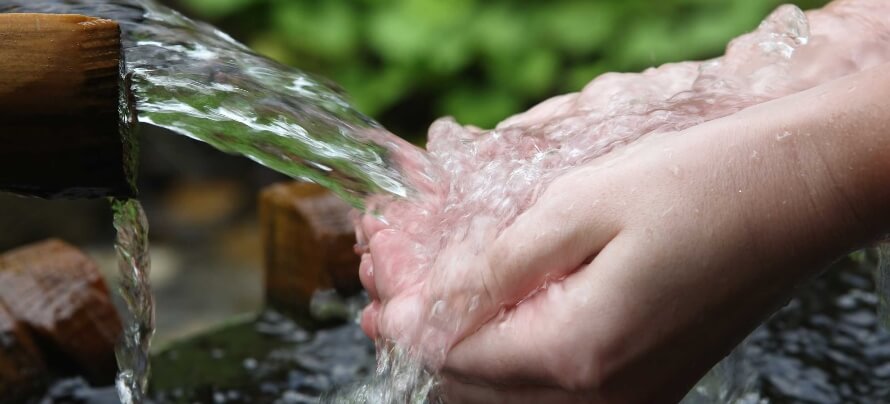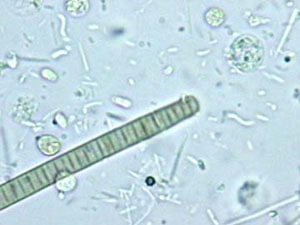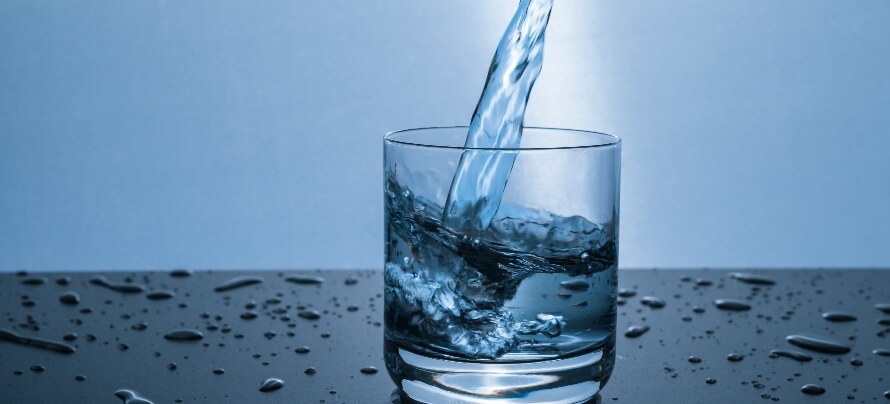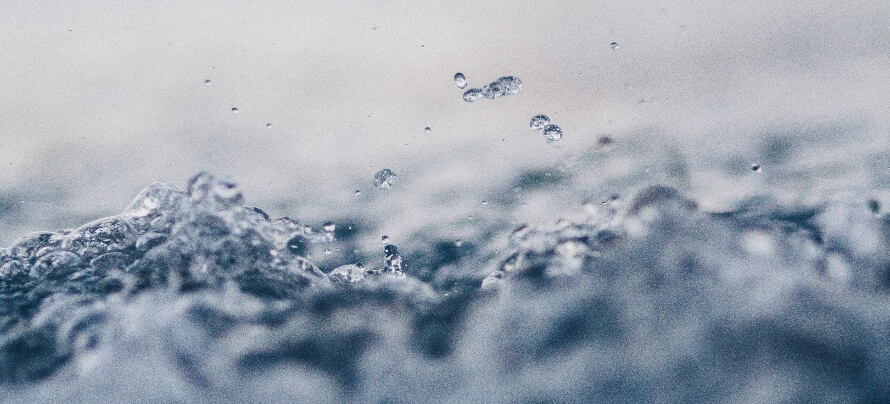Key Takeaways
- Raw water is water that hasn’t been filtered, heated, or treated with any chemicals to remove pathogens and pollutants.
- Proponents of raw water claim it’s good for you because it provides healthy bacteria and minerals and doesn’t contain fluoride or chlorine.
- The truth is that raw water is much more likely to contain pathogens and pollutants, and there are easy, safe, and cheap ways to remove chlorine and fluoride from your water if you want to.
What do you think of when you hear the term “raw water?”
Probably something like this:

Ahh yes, clean, clear, unadulterated spring water from deep within the Earth, naturally purified by Mother Nature.
If you were to look at that water through a microscope, though, it would look more like this:

Not quite so appealing.
According to proponents of raw water, all the stuff you see in that microscope image is what makes raw water good for you.
That’s right—the microbes, bacteria, and other goodies floating in that water does a body good, and filtering, heating, or otherwise processing the water removes these beneficial properties.
They also claim that what raw water doesn’t contain is equally important—namely chemicals like fluoride and chlorine.
According to raw water advocates, raw water gives you the best of both worlds: no harsh chemicals or industrial pollutants, along with the minerals and microbes your body needs.
Are they right?
Are the rest of us compromising our health by drinking artificially processed, unhealthy water?
The short answer is no—drinking raw water is pointless, expensive, and potentially dangerous.
If you want to know more about the raw water fad, including what raw water is, why people drink it, and what science has to say about it, keep reading.
What Is Raw Water?
The Oxford English Dictionary defines “raw” as “(of a material or substance) in its natural state; not yet processed or purified.”
Raw water is water collected from the outdoors—typically from streams or springs—that hasn’t undergone any kind of filtration, treatment, or heating to kill pathogens and remove contaminants.
So, the process for collecting raw water is to get a jug, find a stream, spring, or other body of water in nature, fill it with water, and be on your merry way.
Of course, if you don’t live next to a stream or don’t want to go to the trouble of collecting the raw water yourself, you can find several companies that are happy to sell it to you on a subscription basis. All for a cheap price of $6.40 per gallon—only twice as much as gasoline!
So, how does raw water differ from tap water?
Most of the water people drink comes from public water treatment plants, which use a multi-step process involving filtration and chemicals to remove contaminants and kill microbes. Thanks to the Safe Drinking Water Act of 1974, these plants test for 91 different potential contaminants to ensure they’re within safe limits.
In 24 to 36 hours, water that used to be mixed with sewage is separated, purified, and released back into the wild or sent to another treatment facility before it becomes drinking water again.
Any water in the U.S. that’s destined to become drinking water also has fluoride added to it to help reduce the risk of cavities.
You may be wondering how raw water differs from well water.
After all, well water doesn’t undergo any kind of sanitization or filtration, so it’s more or less the same as raw water, right?
Not exactly.
Well water is gathered by drilling deep into the Earth to reach the groundwater, typically through several layers of rock. Groundwater can be as shallow as a few feet or as deep as 30,000 feet below the surface, but most wells are located in areas where the groundwater is several hundred feet deep.
This deep layer of dirt, sand, and rock acts as a surprisingly effective natural filter, which is why most private wells provide water that’s within the government standards for water treatment plants. That said, it’s always possible for environmental toxins or waste to pollute wells, which is why wells need to be tested at least once a year to ensure the water is safe to drink.
The bottom line, though, is what although well water may not be as reliably clean as water from a treatment plant, both are much, much cleaner than water from streams, rivers, and springs.
Most of the water that makes its way into streams, rivers, and springs comes from rain or snow melt, and it hasn’t undergone any kind of filtration or treatment.
Rain and snow also collect pollutants from the air which are carried into springs, streams, and rivers.
As you’ll learn in a moment, this means that any pollutants or pathogens that are on or near ground level can easily make their way into raw water.
Summary: Raw water is water that hasn’t undergone any kind of filtration, purification, or chemical treatment to remove pathogens or pollutants.
Why Do People Drink Raw Water?

To advocates of raw water, regular bottled, tap, or well water is akin to processed food. Raw water, on the other hand, is the equivalent of organic vegetables.
That’s how they see it, anyway.
There are two primary reasons raw water advocates claim it’s better for you than tap, well, or bottled water:
- They claim raw water has healthy bacteria that you can’t get from tap, well, or bottled water.
- They claim that raw water contains minerals that you can’t get from tap, well or bottled water.
- They claim that raw water doesn’t contain harmful compounds like chlorine and fluoride that are found in tap, well and some bottled water.
Let’s break down these claims.
Raw Water and “Healthy” Bacteria
First, it’s true that raw water contains more healthy bacteria and minerals than tap water.
Ideally, tap water contains virtually no bacteria and very small amounts of minerals. In fact, those are two of the goals of water treatment—removing potentially problematic bacteria and unsafe minerals.
What raw water evangelists don’t tell you, though, is that raw water can also potentially contain large amounts of unhealthy bacteria and minerals.
For example, typhoid is a deadly bacteria that thrives in water, and it’s killed millions of people just in the 20th century. The primary way typhus is spread is by drinking water contaminated by animal or human feces.
Dysentery is another potentially fatal disease that’s often caused by the bacteria shigellosis, which thrives in water.
Cholera is a bacterial infection that kills anywhere from 30 to 130,000 people every year, mostly in undeveloped countries with poor water sanitation.
In fact, a physician named John Snow was able to deduce that cholera was spread by contaminated water before scientists even knew germs existed. How? By tracking cholera cases around London and using statistics to determine that the most likely cause of the outbreak was a single infected well.
Of course, it’s always possible that raw water could contain benign or beneficial bacteria, too, like Bifidobacteria, B. breve, and B. animalis. Maybe.
There’s simply no way of knowing exactly what’s in raw water, though.
It could have healthy bacteria, benign bacteria, or potentially life-threatening bacteria.
Without testing the water for a wide range of potential pathogens, or killing everything to be on the safe side, there’s no way to know what you’re putting into your body when you drink raw water.
Is the small potential benefit of ingesting a handful of healthy bacteria worth the risk of possibly consuming deadly bacteria?
Probably not.
Of course, raw water can contain a number of other potential pathogens like viruses, amoebas, and other parasites, so bacteria aren’t your only concern.
For example, Cryptosporidiosis is a condition caused by microscopic parasites that make their way into streams, rivers, and lakes from animal feces. This is one of the most common causes of water-borne illness in the U.S., and it causes severe diarrhea similar to dysentery.
When confronted with facts like this, some raw water advocated will fall back on the “but our ancestors drank raw water” argument.
Sure, they did, and they died by the millions from disease.
They knew this, too, which is why there are records dating back to 1,500 BCE in Sanskrit and Greek detailing various methods to purify water, such as filtering through charcoal, straining, boiling, exposing water to sunlight, and so forth.
Raw, untreated water has always been a potential threat to human health, and that’s still the case now.
Summary: Raw water can potentially contain any number of potentially deadly bacteria, viruses, and parasites that can cause a wide variety of diseases, even in developed countries.
Raw Water and “Healthy” Minerals
It’s true that raw water contains more minerals than tap or bottled water.
This is because as water seeps through dirt and flows over rock, it dissolves small amounts of various minerals that mix with the water.
And some of these minerals can be good for you.
Calcium, for example, often leaches into water when a stream passes through an area containing limestone (which is high in calcium).
The same thing can happen with rocks and dirt containing calcium, magnesium, manganese, and potassium. When water contains additional minerals obtained from nature, it’s known as “hard” water.
How much of these minerals are you actually getting, though?
Well, according to the U.S. Geological Survey, “moderately hard” water contains 60 to 120 mg of minerals per liter. Most of that will be calcium carbonate, only 40% of which is actual calcium (the other 60% being carbonate).
This means a liter of water (~¼ gallon) contains 24 to 48 mg of calcium. The reference daily intake for calcium is 1,000 mg per day. To get that much calcium from raw water, you’d need to drink 10 to 20 gallons of moderately hard water per day.
Or, you could just eat a halfway healthy diet and get that much calcium from a few servings of vegetables and dairy.
(And if you’d like to know exactly what diet to follow to reach your fitness goals, take the Legion Diet Quiz.)
So, the first problem with the “raw water has minerals” argument is that it has almost no minerals.
The second problem is that it can also contain many compounds that aren’t healthy.
For example, toxic compounds like lead, uranium, arsenic, and cadmium can also be in raw water, or any water that hasn’t been filtered.
Granted, these materials are most common in groundwater contaminated by industrial pollution or lead plumbing, but they can also be found in raw water collected from streams, rivers, and so forth.
Summary: Raw water doesn’t contain nearly enough minerals to make a significant impact on your health, and it can also contain potentially harmful minerals, metals, and other compounds.
Raw Water and Chlorine and Fluoride

Most tap and bottled water contains chlorine and fluoride in the United States.
These two chemicals are added to drinking water to kill pathogens and improve dental hygiene, respectively. Of course, raw water never undergoes processing and doesn’t contain either of these chemicals, which proponents say is a good thing.
Why?
Well, both of these chemicals are controversial.
Chlorine is a yellow-green gas that’s toxic to humans in large amounts. It’s been used since the 1800s as a disinfectant and deodorizer, typically in hospitals, and it was first used to disinfect water in 1897.
Chlorine is exceptionally effective at killing various kinds of bacteria and viruses, including polio. Unfortunately, it can also kill people.
Chlorine was used as a poison gas during World War 1 by both sides, which has tarnished its reputation as a disinfectant ever since.
Naturally, people have concerns about drinking a potentially poisonous chemical.
The chlorine used in chemical warfare isn’t the same as the chlorine used to disinfect drinking water, though.
First, most of the chlorine added to water during treatment is removed before it’s pumped to your faucet, and the amounts left over are far too small to be dangerous to humans.
Second, the negative side effects of chlorine are mostly caused by breathing in concentrated chlorine gas, which isn’t the case when you’re drinking lightly chlorinated water.
Third, you can easily remove the last traces of chlorine from your drinking water by using a cheap filter, like a Brita water filter.
And what about fluoride?
Fluoride is a colorless, tasteless mineral found naturally in water, soil, plants, and rocks. It’s also found naturally in your teeth and bones where it helps improve the structural integrity of these tissues.
Without getting into the politics and ethics of involuntarily giving large groups of people medication, water fluoridation does seem to reduce tooth decay.
For example, a review study conducted by scientists at the University of Manchester found that water fluoridation reduced the rate of dental cavities by 35% in baby teeth and 26% in permanent teeth.
Other research, though, shows water fluoridation might not be as effective as many authorities claim.
For example, a report conducted by the European Commission found that people can get all of the benefits of fluoride from fluoride-containing toothpaste and from the small amount of fluoride in food.
They also found areas that ceased adding fluoride to the water supply didn’t experience an increase in dental cavities (indicating fluoride may not have been preventing them in the first place).
There are also risks to water fluoridation.
If fluoride levels in the water are too high, people (especially children) can develop dental fluorosis. Although this is generally harmless, it does produce white streaks and splotches on the teeth.
In extreme cases, consuming large amounts of fluoride over time can lead to skeletal fluorosis, which is an accumulation of fluoride in bone. This can cause bone and joint pain as well as deformities in the most severe cases.
Luckily, this usually only occurs in areas with naturally high fluoride levels in the water or high levels of fluoride pollution.
Ironically, you may get far more fluoride from raw water than tap water, depending on where you live. For example, the soil in many parts of Africa and Asia naturally contains more fluoride than other areas, and people drinking raw water have developed fluorosis before.
On the whole, countries are still divided about whether or not the benefits of water fluoridation are worth the risks.
Raw water devotees use this lack of consensus to claim that raw water is better for you, but that isn’t the case.
It’s true that raw water doesn’t contain chlorine, and probably doesn’t contain fluoride (if it’s gathered in the U.S.), but there are relatively easy ways to remove these chemicals from your water without exposing yourself to pathogens and other pollutants in raw water.
For example, you can easily remove chlorine with a cheap charcoal filter like a Brita.
Fluoride molecules are harder to remove from water, but a reverse-osmosis filter will get rid of them.
Summary: Chlorine in water isn’t a major health concern, and although the jury is still out on the pros and cons of fluoride, it’s most likely benign or mildly helpful.
If you want to avoid these two chemicals, you can also remove them from tap water with proper filtration methods.
The Bottom Line on Raw Water

Raw water is water collected from the outdoors—typically from streams or springs—that hasn’t undergone any kind of filtration, treatment, or heating to kill pathogens and remove contaminants.
Proponents of raw water claim this lack of water treatment is good for you.
Treating the water removes the minerals and healthy bacteria, they say. Plus, raw water doesn’t contain any harmful chlorine or fluoride, like tap water, they add.
The reality is raw water can and usually does contain many bacteria, some of which might be beneficial, but most of which are either benign or harmful. Raw water can also contain many other pathogens such as viruses, amoebas, and parasites which can cause a long list of diseases even in developed countries.
Raw water also contains more minerals than tap or bottled water, but not enough to have any impact on your health. What’s more, it’s also more likely to contain heavy metals and other pollutants.
Finally, although most tap and bottled water contains chlorine, the amount is too small to have any impact on your health. You can also easily remove chlorine from your drinking water by filtering it with a cheap charcoal filter.
Although there’s little evidence fluoride is harmful, it’s easy enough to remove by using a reverse-osmosis filter.
The bottom line is that raw water is more or less an alternative health scam.
If I were you, I’d stick with the water you have now.
What’s your take on raw water? Have anything else to share? Let me know in the comments below!










